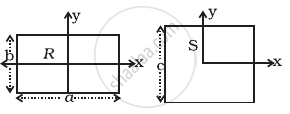Advertisements
Advertisements
प्रश्न
A uniform square plate S (side c) and a uniform rectangular plate R (sides b, a) have identical areas and masses (Figure).

Show that
- IxR/IxS < 1
- IyR/IyS > 1
- IzR/IzS > 1
उत्तर
According to the problem,
Area of square = area of rectangular plate
⇒ `c^2 = a xx b`
⇒ `c^2 = ab`
a. `I_(xR)/I_(xS) = b^2/c^2` ......[∵ I ∝ (area)2]
It is clear from the diagram that b < c
⇒ `I_(xR)/I_(xS) = (b/c)^2 < 1`
⇒ `I_(xR) < I_(xS)`
b. `I_(yR)/I_(yS) = a^2/c^2` ......(It is clear that a < c)
`I_(yR)/I_(yS) - (a/c)^2 > 1`
c. `I_(zR) = 1/12 M(a^2 + b^2)`
`I_(zS) = 1/12 M(c^2 + c^2)`
Now, `I_(zR) - I_(zS) = 1/12 M[a^2 + b^2 - 2c^2]`
= `1/12 M(a^2 + b^2 - 2ab)`
`I_(zR) - I_(zS) = 1/12 M(a - b)^2 > 0`
⇒ `I_(zR)/I_(zS) > 1`
APPEARS IN
संबंधित प्रश्न
A child sits stationary at one end of a long trolley moving uniformly with a speed V on a smooth horizontal floor. If the child gets up and runs about on the trolley in any manner, what is the speed of the CM of the (trolley + child) system?
If all the particles of a system lie in X-Y plane, is it necessary that the centre of mass be in X-Y plane?
A collision experiment is done on a horizontal table kept in an elevator. Do you expect a change in the result if the elevator is accelerated up or down because of the noninertial character of the frame?
A circular plate of diameter d is kept in contact with a square plate of edge d as show in figure. The density of the material and the thickness are same everywhere. The centre of mass of the composite system will be 
In which of the following cases the centre of mass of a rod is certainly not at its centre?
(a) the density continuously increases from left to right
(b) the density continuously decreases from left to right
(c) the density decreases from left to right upto the centre and then increases
(d) the density increases from left to right upto the centre and then decreases.
If the external force acting on a system have zero resultant, the centre of mass
(a) must not move
(b) must not accelerate
(c) may move
(d) may accelerate.
Calculate the velocity of the centre of mass of the system of particles shown in figure.

During a heavy rain, hailstones of average size 1.0 cm in diameter fall with an average speed of 20 m/s. Suppose 2000 hailstones strike every square meter of a 10 m × 10 m roof perpendicularly in one second and assume that the hailstones do not rebound. Calculate the average force exerted by the falling hailstones on the roof. Density of a hailstone is 900 kg/m3.
A bullet of mass 20 gram is fired from a gun of mass 2.5 kg with a speed of 750 m/s. The magnitude of recoil velocity of the gun is ______.
In rotational motion of a rigid body, all particles move with ______.
